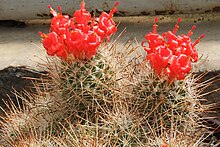Cochemiea poselgeri
| Cochemiea poselgeri | |
|---|---|

| |
| Scientific classification | |
| Kingdom: | Plantae |
| Clade: | Tracheophytes |
| Clade: | Angiosperms |
| Clade: | Eudicots |
| Order: | Caryophyllales |
| Family: | Cactaceae |
| Subfamily: | Cactoideae |
| Genus: | Cochemiea |
| Species: | C. poselgeri
|
| Binomial name | |
| Cochemiea poselgeri (Hildm.) Britton & Rose 1923
| |
| Synonyms | |
| |
Cochemiea poselgeri is a species of Cochemiea found in Mexico[2]
Description[edit]
Cochemiea poselgeri grows in branching clusters from the base, forming large groups. The shoots are cylindrical, up to 2 meters long and 4 centimeters in diameter, often hanging over rocks. The triangular warts are slightly rounded at the top and spaced apart. The axillae are woolly with a few bristles. The Areoles are white and wooly with a hooked central spine is 1.5 to 2 centimeters long, and there are up to 8 radial spines, 1 centimeter long, brown with white tips.
The flowers are red, 3 centimeters in size, with crooked edges. The fruits are red and range from spherical to broadly elongated, 6 to 8 mm in diameter.[3]
-
Flower
-
Spines closeup
-
Plant
-
Fruit
Distribution[edit]
Cochemiea poselgeri is widespread in Baja California Sur, Mexico at elevations of 0 to 120 meters. It is found growing on flat sandy areas, on rocks and hanging off cliffs and ridges. Plants are found growing among Cochemiea fraileana, Cochemiea schumannii, Cochemiea dioica, Lophocereus schottii, Stenocereus gummosus, Echinocereus brandegeei, Echinocereus barthelowanus, Pachycereus pringlei, Pachycereus pecten-aboriginum, Stenocereus thurberi, Ferocactus townsendianus, Peniocereus johnstonii, Opuntia tapona, Cylindropuntia molesta, Opuntia invicta, Cylindropuntia cholla and Jatropha cinerea.[4]
-
Plant growing in habitat in La Paz, Baja California Sur
Taxonomy[edit]
Originally described as Mammillaria poselgeri by Heinrich Hildmann in 1885, the species name honors German botanist Heinrich Poselger.[5] Nathaniel Lord Britton and Joseph Nelson Rose reclassified it into the genus Cochemiea in 1923.[6]
References[edit]
- ^ "The IUCN Red List of Threatened Species". IUCN Red List of Threatened Species. 2010-05-12. Retrieved 2024-06-01.
- ^ "Cochemiea poselgeri (Hildm.) Britton & Rose". Plants of the World Online. Retrieved 2024-04-21.
- ^ Anderson, Edward F. (2011). Das große Kakteen-Lexikon (in German). Stuttgart (Hohenheim): Ulmer. p. 403. ISBN 978-3-8001-5964-2.
- ^ "Cochemiea poselgeri". LLIFLE. 2013-08-04. Retrieved 2024-06-01.
 This article incorporates text from this source, which is available under the CC BY-SA 3.0 license.
This article incorporates text from this source, which is available under the CC BY-SA 3.0 license.
- ^ Wittmack, Ludwig; Perring, W.; Gartenbaues, Verein zur Beförderung des; Berlins., Gesellschaft des Gartenfreunde (1885). "Garten-Zeitung". P. Parey. Retrieved 2024-06-01.
- ^ Britton, Nathaniel Lord; Eaton, Mary E.; Rose, J. N.; Wood, Helen Adelaide (1919). The Cactaceae : descriptions and illustrations of plants of the cactus family. Washington: Carnegie Institution of Washington. doi:10.5962/bhl.title.46288.
External links[edit]
 Media related to Cochemiea poselgeri at Wikimedia Commons
Media related to Cochemiea poselgeri at Wikimedia Commons Data related to Cochemiea poselgeri at Wikispecies
Data related to Cochemiea poselgeri at Wikispecies







